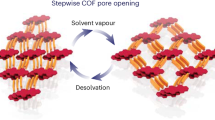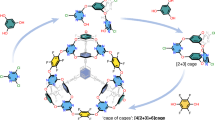Abstract
Porous materials are important in a wide range of applications including molecular separations and catalysis. We demonstrate that covalently bonded organic cages can assemble into crystalline microporous materials. The porosity is prefabricated and intrinsic to the molecular cage structure, as opposed to being formed by non-covalent self-assembly of non-porous sub-units. The three-dimensional connectivity between the cage windows is controlled by varying the chemical functionality such that either non-porous or permanently porous assemblies can be produced. Surface areas and gas uptakes for the latter exceed comparable molecular solids. One of the cages can be converted by recrystallization to produce either porous or non-porous polymorphs with apparent Brunauer–Emmett–Teller surface areas of 550 and 23 m2 g−1, respectively. These results suggest design principles for responsive porous organic solids and for the modular construction of extended materials from prefabricated molecular pores.
This is a preview of subscription content, access via your institution
Access options
Subscribe to this journal
Receive 12 print issues and online access
$259.00 per year
only $21.58 per issue
Buy this article
- Purchase on Springer Link
- Instant access to full article PDF
Prices may be subject to local taxes which are calculated during checkout






Similar content being viewed by others
References
Barbour, L. J. Crystal porosity and the burden of proof. Chem. Commun. 1163–1168 (2006).
Cheetham, A. K., Férey, G. & Loiseau, T. Open-framework inorganic materials. Angew. Chem. Int. Ed. 38, 3268–3292 (1999).
Kitagawa, S., Kitaura, R. & Noro, S. Functional porous coordination polymers. Angew. Chem. Int. Ed. 43, 2334–2375 (2004).
Côté, A. P. et al. Porous, crystalline, covalent organic frameworks. Science 310, 1166–1170 (2005).
Atwood, J. L., Barbour, L. J. & Jerga, A. Storage of methane and freon by interstitial van der Waals confinement. Science 296, 2367–2368 (2002).
Thallapally, P. K. et al. Carbon dioxide capture in a self-assembled organic nanochannels. Chem. Mater. 19, 3355–3357 (2007).
Thallapally, P. K. et al. Gas-induced transformation and expansion of a non-porous organic solid. Nature Mater. 7, 146–150 (2008).
Langley, P. J. & Hulliger, J. Nanoporous and mesoporous organic structures: New openings for materials research. Chem. Soc. Rev. 28, 279–291 (1999).
Sozzani, P., Bracco, S., Comotti, A., Ferretti, L. & Simonutti, R. Methane and carbon dioxide storage in a porous van der Waals crystal. Angew. Chem. Int. Ed. 44, 1816–1820 (2005).
Barrer, R. M. & Shanson, V. H. Dianin’s compound as a zeolitic sorbent. J. Chem. Soc. Chem. Commun. 333–334 (1976).
Lim, S. et al. Cucurbit[6]uril: Organic molecular porous material with permanent porosity, exceptional stability, and acetylene sorption properties. Angew. Chem. Int. Ed. 47, 3352–3355 (2008).
Comotti, A., Bracco, S., Distefano, G. & Sozzani, P. Methane, carbon dioxide and hydrogen storage in nanoporous dipeptide-based materials. Chem. Commun. 284–286 (2009).
Sudik, A. C. et al. Design, synthesis, structure, and gas (N2, Ar, CO2, CH4, and H2) sorption properties of porous metal–organic tetrahedral and heterocuboidal polyhedra. J. Am. Chem. Soc. 127, 7110–7118 (2005).
Fujita, M. et al. Molecular paneling via coordination. Chem. Commun. 509–518 (2001).
Budd, P. M. et al. Polymers of intrinsic microporosity (PIMs): Robust, solution-processable, organic nanoporous materials. Chem. Commun. 230–231 (2004).
Bradshaw, D. et al. Design, chirality, and flexibility in nanoporous molecule-based materials. Acc. Chem. Res. 38, 273–282 (2005).
El-Kaderi, H. M. et al. Designed synthesis of 3D covalent organic frameworks. Science 316, 268–272 (2007).
Kuhn, P., Antonietti, M. & Thomas, A. Porous, covalent triazine-based frameworks prepared by ionothermal synthesis. Angew. Chem. Int. Ed. 47, 3450–3453 (2008).
Conway, J. H. & Torquato, S. Packing, tiling, and covering with tetrahedra. Proc. Natl Acad. Sci. USA 103, 10612–10617 (2006).
MacGillivray, L. R. & Atwood, J. L. Structural classification and general principles for the design of spherical molecular hosts. Angew. Chem. Int. Ed. 38, 1019–1034 (1999).
Furutani, Y. et al. In situ spectroscopic, electrochemical, and theoretical studies of the photoinduced host–guest electron transfer that precedes unusual host-mediated alkane photooxidation. J. Am. Chem. Soc. 131, 4764–4768 (2009).
Liu, X. J., Liu, Y., Li, G. & Warmuth, R. One-pot, 18-component synthesis of an octahedral nanocontainer molecule. Angew. Chem. Int. Ed. 45, 901–904 (2006).
Mastalerz, M. One-pot synthesis of a shape-persistent endo-functionalised nano-sized adamantoid compound. Chem. Commun. 4756–4758 (2008).
Skowronek, P. & Gawronski, J. Chiral iminospherand of a tetrahedral symmetry spontaneously assembled in a [6+4] cycloaddition. Org. Lett. 10, 4755–4758 (2008).
Mecozzi, S. & Rebek, J. The 55% solution: A formula for molecular recognition in the liquid state. Chem. Eur. J. 4, 1016–1022 (1998).
Graf, E. & Lehn, J. M. Synthesis and cryptate complexes of a spheroidal macrotricyclic ligand with octahedrotetrahedral coordination. J. Am. Chem. Soc. 97, 5022–5024 (1975).
Stang, P. J., Olenyuk, B., Muddiman, D. C. & Smith, R. D. Transition-metal-mediated rational design and self-assembly of chiral, nanoscale supramolecular polyhedra with unique T symmetry. Organometallics 16, 3094–3096 (1997).
Fiedler, D. et al. Selective molecular recognition, C–H bond activation, and catalysis in nanoscale reaction vessels. Acc. Chem. Res. 38, 349–358 (2005).
Ajami, D. & Rebek, J. Gas behaviour in self-assembled capsules. Angew. Chem. Int. Ed. 47, 6059–6061 (2008).
Iyer, K. S., Norret, M., Dalgarno, S. J., Atwood, J. L. & Raston, C. L. Loading molecular hydrogen cargo within viruslike nanocontainers. Angew. Chem. Int. Ed. 47, 6362–6366 (2008).
Soldatov, D. V. et al. α- and β-bis(1,1,1-trifluoro-5,5-dimethyl-5-methoxyacetylacetonato)copper(II ): Transforming the dense polymorph into a versatile new microporous framework. J. Am. Chem. Soc. 121, 4179–4188 (1999).
Soldatov, D. V. & Ripmeester, J. A. Inclusion in microporous β-bis(1,1,1-trifluoro-5,5-dimethyl-5-methoxyacetylacetonato)copper(II), an organic zeolite mimic. Chem. Mater. 12, 1827–1839 (2000).
Lin, X. et al. High H2 adsorption by coordination-framework materials. Angew. Chem. Int. Ed. 45, 7358–7364 (2006).
Weber, J., Antonietti, M. & Thomas, A. Microporous networks of high-performance polymers: Elastic deformations and gas sorption properties. Macromolecules 41, 2880–2885 (2008).
Atwood, J. L., Barbour, L. J., Jerga, A. & Schottel, B. L. Guest transport in a nonporous organic solid via dynamic van der Waals cooperativity. Science 298, 1000–1002 (2002).
Banerjee, R. et al. Control of pore size and functionality in isoreticular zeolitic imidazolate frameworks and their carbon dioxide selective capture properties. J. Am. Chem. Soc. 131, 3875–3877 (2009).
Tian, J., Thallapally, P. K., Dalgarno, S. J., McGrail, P. B. & Atwood, J. L. Amorphous molecular organic solids for gas adsorption. Angew. Chem. Int. Ed. 48, 5492–5495 (2009).
O’Reilly, N., Giri, N. & James, S. L. Porous liquids. Chem. Eur. J. 13, 3020–3025 (2007).
Zhang, J.-X., Zheng, Y.-P., Yu, P.-Y., Mo, S. & Wang, R.-M. Modified carbon nanotubes with liquid-like behaviour at 45 ∘C. Carbon 47, 2776–2781 (2009).
Acknowledgements
We thank the Engineering and Physical Sciences Research Council (EPSRC) for financial support under grant EPSRC/C511794 and Kaneka Corporation, Japan, for financial supporting a research visit for T.T. We thank the STFC for access to Diamond and M.J. Rosseinsky for helpful advice. A.C. is a Royal Society Wolfson Research Merit Award holder.
Author information
Authors and Affiliations
Contributions
T.T., S.I.S., S.J., D.J.A. and S.S. synthesized cages 1–3, J.T.A.J. and R.C. carried out volumetric sorption measurements, D.B. carried out gravimetric sorption measurements, T.H. carried out microscopy, desolvation studies and TGA, A.T. constructed the molecular models and carried out the sorption simulations, J.B., A.M.Z.S., S.Y.C., C.T., S.T., J.P. and A.S. carried out the crystallography; in particular J.B. and A.S. solved the crucial first structure for the cage 1 ethyl acetate solvate. J.T.A.J. discovered the porous polymorph of 1. A.I.C. conceived the experiments; all authors contributed to writing the paper.
Corresponding author
Supplementary information
Supplementary Information
Supplementary Information (PDF 2191 kb)
Rights and permissions
About this article
Cite this article
Tozawa, T., Jones, J., Swamy, S. et al. Porous organic cages. Nature Mater 8, 973–978 (2009). https://doi.org/10.1038/nmat2545
Received:
Accepted:
Published:
Issue Date:
DOI: https://doi.org/10.1038/nmat2545
This article is cited by
-
Computationally guided synthesis of a hierarchical [4[2+3]+6] porous organic ‘cage of cages’
Nature Synthesis (2024)
-
Self-similar chiral organic molecular cages
Nature Communications (2024)
-
Polycage membranes for precise molecular separation and catalysis
Nature Communications (2023)
-
Synthesis of covalent organic pillars as molecular nanotubes with precise length, diameter and chirality
Nature Synthesis (2023)
-
The sharp structural switch of covalent cages mediated by subtle variation of directing groups
Nature Communications (2023)



